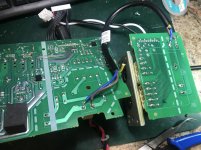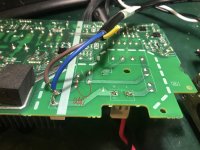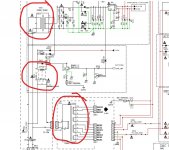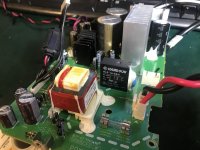Hi all , i'm a bit stuck with a power supply , i have this marantz cd 6006 player i am trying to fix , there seemed to be an issue with the drive motor but i think it was down to the power supply failing , the main transformer is separate , i get 240v at the main transformer plug but it drops to 0 when i plug it in , i thought the transformer could have been shorted but it seems ok .
When i connect the transformer directly to the mains and it works ok without getting hot .
Here are some photos of the psu , i have checked all the caps on the power board , they seem fine . and the 2 transistors on the black heatsinks , they are ok , The third black heatsink is a voltage regulator (7805A) there is no voltage getting to this though ..
If anyone is familiar with this board and could point me in the right direction i would be very grateful .
Dropbox - marantz psu.jpg - Simplify your life
Dropbox - Photo 25-01-2020, 10 10 57 am.jpg - Simplify your life
heres the back of the board
Dropbox - Photo 28-01-2020, 6 49 13 pm.jpg - Simplify your life
When i connect the transformer directly to the mains and it works ok without getting hot .
Here are some photos of the psu , i have checked all the caps on the power board , they seem fine . and the 2 transistors on the black heatsinks , they are ok , The third black heatsink is a voltage regulator (7805A) there is no voltage getting to this though ..
If anyone is familiar with this board and could point me in the right direction i would be very grateful .
Dropbox - marantz psu.jpg - Simplify your life
Dropbox - Photo 25-01-2020, 10 10 57 am.jpg - Simplify your life
heres the back of the board
Dropbox - Photo 28-01-2020, 6 49 13 pm.jpg - Simplify your life
Last edited:
Hello. Check the continuity of the windings of the transformer with an ohmeter, analog or digital. High voltages will measure higher resistances because of they have many turns of thin wire while lower voltage will give little resistance as they have few turns of fat wires. No one must measure more than 2KΩ.
Hello. Check the continuity of the windings of the transformer with an ohmeter, analog or digital. High voltages will measure higher resistances because of they have many turns of thin wire while lower voltage will give little resistance as they have few turns of fat wires. No one must measure more than 2KΩ.
heres what i am getting . sorry about the crudeness of the drawing ..
Dropbox - Photo 28-01-2020, 7 10 33 pm.jpg - Simplify your life
Verify the possibility of broken solderings. It isn't uncommon that thermal fatigue breaks the solder pads and the tin. Please, try a current limited power supply like this when playing with live sets.
It would be much better if you could attach your images directly to the forum 🙂 Hosting them on 3rd party sites stops many from joining in...
Like this:
How to attach images to your posts.
Like this:
How to attach images to your posts.
It would be much better if you could attach your images directly to the forum 🙂 Hosting them on 3rd party sites stops many from joining in...
Like this:
How to attach images to your posts.
Sorry , i thought it was better hosting on 3rd party due to clogging space up on the forum ..
i will add them ..
Verify the possibility of broken solderings. It isn't uncommon that thermal fatigue breaks the solder pads and the tin. Please, try a current limited power supply like this when playing with live sets.
Thanks , current limiter maybe a job for this weekend ,
the solder joints all looked ok , but i remade them just to be safe .
Sorry , i thought it was better hosting on 3rd party due to clogging space up on the forum ..
i will add them ..
Thanks 🙂
Space is no problem. The reason we prefer it is to stop this, of which the forum is littered:
Post your Solid State pics here.
and this:
Post your Solid State pics here.
As to your fault...
The primary voltage on the transformer dropping from 240V to 0V when you power up and plug the transformer in suggest a very high resistance connection somewhere.
Bizarre causes can be actual fuses themselves where the fuse wire is just touching the end cap internally. I've come across that only once or twice in literally thousands of repairs over many years. Also fuse holders. Check the mains plug as well.
Mains switches are another much more likely cause. Even a fracture in the mains lead could do this.
It has to be something like this causing the incoming supply voltage to fall to zero.
The primary voltage on the transformer dropping from 240V to 0V when you power up and plug the transformer in suggest a very high resistance connection somewhere.
Bizarre causes can be actual fuses themselves where the fuse wire is just touching the end cap internally. I've come across that only once or twice in literally thousands of repairs over many years. Also fuse holders. Check the mains plug as well.
Mains switches are another much more likely cause. Even a fracture in the mains lead could do this.
It has to be something like this causing the incoming supply voltage to fall to zero.
Could you check that PCB traces aren't cut just in the join with PCB pads? Many times thermal job of the trafo's pins break these joints. Some manufacturer use eyelets to prevent it, but the majority doesn't.
Thanks 🙂
Space is no problem. The reason we prefer it is to stop this, of which the forum is littered:
Post your Solid State pics here.
and this:
Post your Solid State pics here.
No problem , will post photos direct from now on .. 😀
Last edited by a moderator:
As to your fault...
The primary voltage on the transformer dropping from 240V to 0V when you power up and plug the transformer in suggest a very high resistance connection somewhere.
Bizarre causes can be actual fuses themselves where the fuse wire is just touching the end cap internally. I've come across that only once or twice in literally thousands of repairs over many years. Also fuse holders. Check the mains plug as well.
Mains switches are another much more likely cause. Even a fracture in the mains lead could do this.
It has to be something like this causing the incoming supply voltage to fall to zero.
ok , tried another fuse , a different mains lead and a different wall outlet . same fault ,
Well that's progress 🙂
So something has to be open somewhere. Those connectors (white plug in your picture) can give problems. Occasionally just a slack contact or perhaps the crimping is bad.
So something has to be open somewhere. Those connectors (white plug in your picture) can give problems. Occasionally just a slack contact or perhaps the crimping is bad.
Last edited:
Its a bit hard to figure out from pictures... however there appears to be a relay and a small auxiliary standby power supply.
If it is configured like that then is the relay closing correctly?
Is the standby supply OK? It is quite common for the internal thermal fuse to fail on these small kinds of transformers.
The 240V across that ceramic cap suggests the relay is not closed. I think it is wired across the contact. This is also why you see 240V when the transformer is not connected. The cap allows enough AC current to pass so that the meter reads the open circuit voltage correctly.
If it is configured like that then is the relay closing correctly?
Is the standby supply OK? It is quite common for the internal thermal fuse to fail on these small kinds of transformers.
The 240V across that ceramic cap suggests the relay is not closed. I think it is wired across the contact. This is also why you see 240V when the transformer is not connected. The cap allows enough AC current to pass so that the meter reads the open circuit voltage correctly.
I have a Marantz Pearl Lite SACD and the PSU is fairly similar. Small standby transformer at the top, the relay in the middle and the large main transformer below.
If the transformer is open then it should be possible to fit a small generic replacement for well under a fiver.
Edit... I remembered this from last year which could be similar.
Marantz SA-KI Pearl Lite REPAIR
If the transformer is open then it should be possible to fit a small generic replacement for well under a fiver.
Edit... I remembered this from last year which could be similar.
Marantz SA-KI Pearl Lite REPAIR
Attachments
I have a Marantz Pearl Lite SACD and the PSU is fairly similar. Small standby transformer at the top, the relay in the middle and the large main transformer below.
If the transformer is open then it should be possible to fit a small generic replacement for well under a fiver.
Edit... I remembered this from last year which could be similar.
Marantz SA-KI Pearl Lite REPAIR
The relay seems ok i put 24 vdc across the coil and it seems to be closing ok
Attachments
- Home
- Amplifiers
- Power Supplies
- marantz cd6006 power supply issue
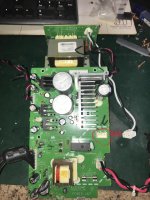
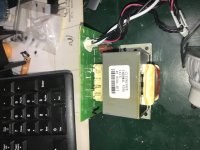
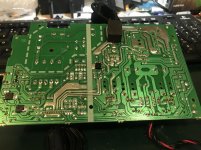
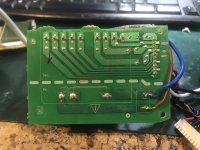
 OK
OK